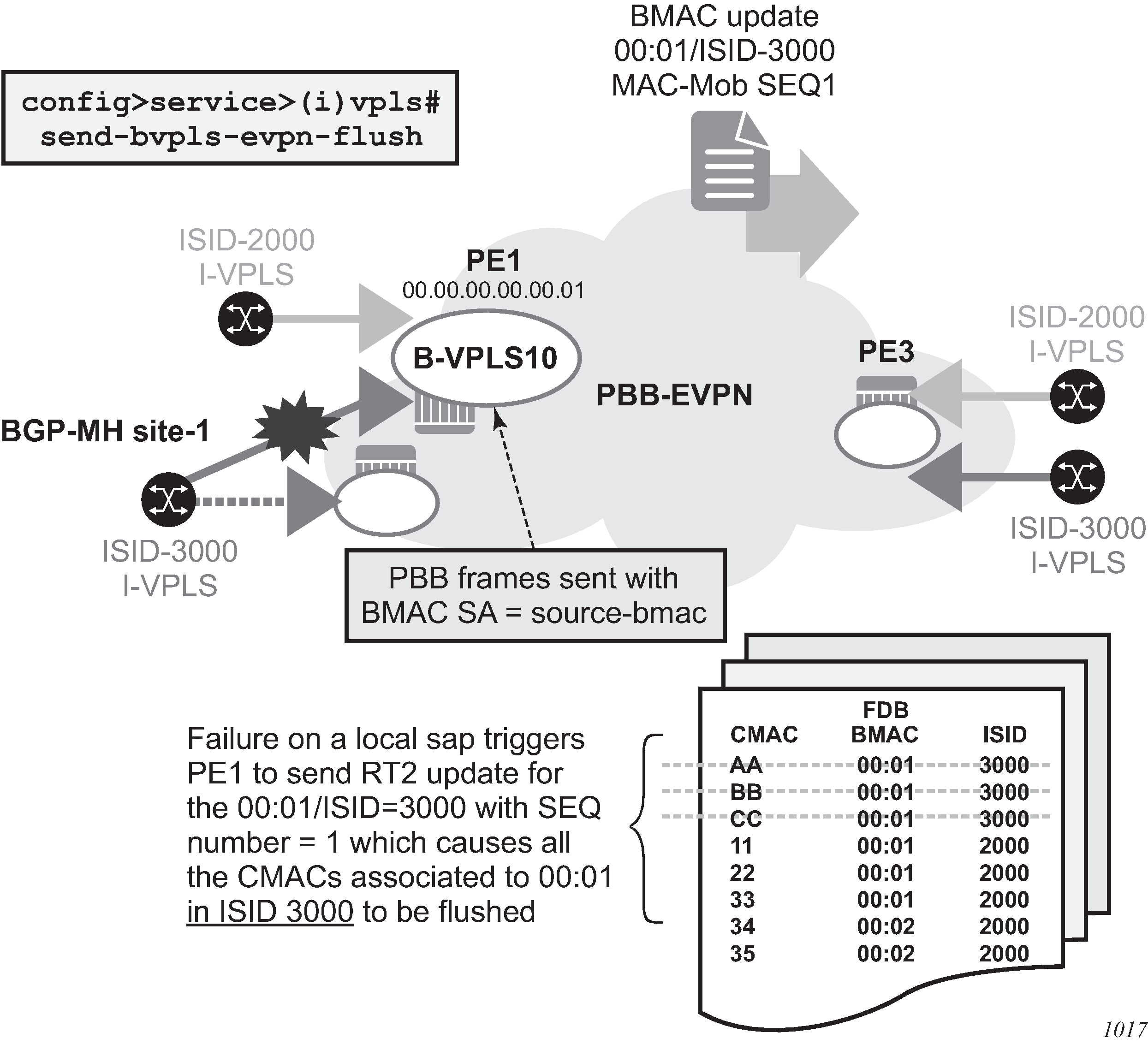SR OS supports ISID-based C-MAC flush procedures for PBB-EVPN I-VPLS services where no single-active ESs are used. SR OS also supports C-MAC flush procedure where other redundancy mechanisms, such as BGP-MH, need these procedures to avoid blackholes caused by a SAP or spoke SDP failure.
The C-MAC flush procedures are enabled on the I-VPLS service using the config>service>vpls>pbb>send-bvpls-evpn-flush CLI command. The feature can be disabled on a per-SAP or per-spoke SDP basis by using the disable-send-bvpls-evpn-flush command in the config>service>vpls>sap or config>service>vpls>spoke-sdp context.
With the feature enabled on an I-VPLS service and a SAP or spoke SDP, if there is a SAP or spoke SDP failure, the router sends a C-MAC flush notification for the corresponding B-MAC and ISID. The router receiving the notification flushes all the C-MACs associated with the indicated B-MAC and ISID when the config>service>vpls>bgp-evpn>accept-ivpls-evpn-flush command is enabled for the B-VPLS service.
The C-MAC flush notification consists of an EVPN B-MAC route that is encoded as follows: the ISID to be flushed is encoded in the Ethernet Tag field and the sequence number is incremented with respect to the previously advertised route.
If send-bvpls-evpn-flush is configured on an I-VPLS with SAPs or spoke SDPs, one of the following rules must be observed:
-
The disable-send-bvpls-evpn-flush option is configured on the SAPs or spoke SDPs.
-
The SAPs or spoke SDPs are not on an ES.
-
The SAPs or spoke SDPs are on an ES or vES with no src-bmac-lsb enabled.
-
The no use-es-bmac is enabled on the B-VPLS.
ISID-based C-MAC flush can be enabled in I-VPLS services with ES or vES. If enabled, the expected interaction between the RFC 7623-based C-MAC flush and the ISID-based C-MAC flush is as follows.
If send-bvpls-evpn-flush is enabled in an I-VPLS service, the ISID-based C-MAC flush overrides (replaces) the RFC 7623-based C-MAC flushing.
For each ES, vES, or B-VPLS, the system checks for at least one I-VPLS service that does not have send-bvpls-evpn-flush enabled.
If ISID-based C-MAC flush is enabled for all I-VPLS services, RFC 7623-based C-MAC flushing is not triggered; only ISID-based C-MAC flush notifications are generated.
If at least one I-VPLS service is found with no ISID-based C-MAC flush enabled, then RFC 7623-based C-MAC flushing notifications are triggered based on ES events.
ISID-based C-MAC flush notifications are also generated for I-VPLS services that have send-bvpls-evpn-flush enabled.
Figure: Per-ISID C-MAC flush following a SAP failure shows an example where the ISID-based C-MAC flush prevents blackhole situations for a CE that is using BGP-MH as the redundancy mechanism in the I-VPLS with an ISID of 3000.

When send-bvpls-evpn-flush is enabled, the I-VPLS service is ready to send per-ISID C-MAC flush messages in the form of B-MAC/ISID routes. The first B-MAC/ISID route for an I-VPLS service is sent with sequence number zero; subsequent updates for the same route increment the sequence number. A B-MAC/ISID route for the I-VPLS is advertised or withdrawn during the following cases:
I-VPLS send-bvpls-evpn-flush configuration and deconfiguration
I-VPLS association and disassociation from the B-VPLS service
I-VPLS operational status change (up/down)
B-VPLS operational status change (up/down)
B-VPLS bgp-evpn mpls status change (no shutdown/shutdown)
B-VPLS operational source B-MAC change
If no disable-send-bvpls-evpn-flush is configured for a SAP or spoke SDP, upon a failure on that SAP or spoke SDP, the system sends a per-ISID C-MAC flush message; that is, a B-MAC/ISID route update with an incremented sequence number.
If the user explicitly configures disable-send-bvpls-evpn-flush for a SAP or spoke SDP, the system does not send per-ISID C-MAC flush messages for failures on that SAP or spoke SDP.
The B-VPLS on the receiving node must be configured with bgp-evpn>accept-ivpls-evpn-flush to accept and process C-MAC flush non-zero Ethernet-tag MAC routes. If the accept-ivpls-evpn-flush command is enabled (the command is disabled by default), the node accepts non-zero Ethernet-tag MAC routes (B-MAC/ISID routes) and processes them. When a new B-MAC/ISID update (with an incremented sequence number) for an existing route is received, the router flushes all the C-MACs associated with that B-MAC and ISID. The B-MAC/ISID route withdrawals also cause a C-MAC flush.
The following CLI example shows the commands that enable the C-MAC flush feature on PE1 and PE3.
*A:PE-1>config>service>vpls(i-vpls)# info
----------------------------------------------
pbb
backbone-vpls 10
send-bvpls-evpn-flush
exit
exit
bgp
route-distinguisher 65000:1
vsi-export ‟vsi_export”
vsi-import ‟vsi_import”
exit
site ‟CE-1” create
site-id 1
sap lag-1:1
site-activation-timer 3
no shutdown
exit
sap lag-1:1 create
no disable-send-bvpls-evpn-flush
no shutdown
exit
<snip>
*A:PE-3>config>service>vpls(b-vpls 10)# info
----------------------------------------------
<snip>
bgp-evpn
accept-ivpls-evpn-flush
In the preceding example, with send-bvpls-evpn-flush enabled on the I-VPLS service of PE1, a B-MAC/ISID route (for pbb source-bmac address B-MAC 00:..:01 and ISID 3000) is advertised. If the SAP goes operationally down, PE1 sends an update of the source B-MAC address (00:..:01) for ISID 3000 with a higher sequence number.
With accept-ivpls-evpn-flush enabled on PE3’s B-VPLS service, PE3 flushes all C-MACs associated with B-MAC 00:01 and ISID 3000. The C-MACs associated with other B-MACs or ISIDs are retained in PE3’s FDB.